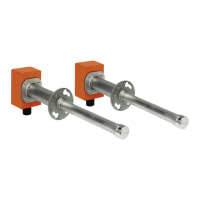18 FLOWSIC100 · Operating Instructions · 8012513/YSA5/V2-1/2016-07 · © SICK Engineering GmbH
Product Description
Subject to change without notice
The modules are selected on the basis of the following criteria:
● Gas temperature
Decide whether the sender/receiver unit must or can be used with or without internal
cooling air so that the duct probe can be selected with regard to type of material (steel,
titanium) and the transducer type (with/without internal cooling)
● Gas composition (corrosive / slightly corrosive or not corrosive)
The duct probe and transducers are selected on the basis of their resistance to corro-
sion (probe made from stainless steel / titanium, transducers made from titanium /
hastelloy)
● Duct diameter, sound dampening, dust content
The transducers are selected on the basis of the required transmitter power (medium
power / high power)
● Dust properties
Decide whether purged sender/receiver units need to be used (prevention of contami-
nation with very sticky dust).
● Wall and insulation thickness of the gas duct
Selection of the duct probe and flange with tube according to the nominal length
(graded standard lengths). Other lengths can be supplied on request.
● Assembly type
On two sides, each with a sender/receiver unit on the opposite duct walls, or on one
side with one sender/receiver unit (as measuring probe version)
● Flange size
Small or large flange dimensions
(pitch diameter of the fixing holes 75 mm, 100 mm or 114 mm)
● Internal duct pressure
Pressure resistant versions must be used with pressures above 100 mbar (see OI
FLOWSIC100 PROCESS)
● Certification requirements
Selection after performance tests for emission measuring.
The various configuration options are identified by a type key structured as follows:

